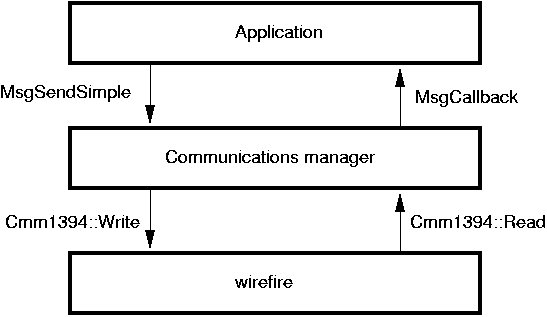HAVi
Common issues for distributed systems
-
Types of devices
-
"legacy" versus "aware" devices
-
Transport mechanisms
-
Identity of devices and components
-
Advertisement of services
-
Service discovery
-
Service invocation
-
Failure
-
User interfaces
HAVi
HAVi (Home Audio Visual Interoperability Architecture)
is concerned with the following home devices
-
tuner
-
VCR
-
clock
-
camera
-
AV disk
-
display
-
amplifier
-
modem
-
web proxy
It is extensible to other Consumer Electronics (CE) devices
Firewire
-
IEEE 1394 standard arising from Apple Computers, also known as i.LINK
-
Data transfer rates to 400Mbps, with 3200Mbps planned
-
Connect upto 63 devices without needing hubs
-
An isochronous protocol - it provides guaranteed delivery
of data packets at regular time intervals. i.e. a real-time transport,
unlike best-effort ethernet. It gives QOS by bandwidth-reservation
-
Plug and play: when a device joins or leaves a network, it causes a bus reset
which generates events and reassigns firewire addresses
-
Firewire addresses share a 64-bit address space: 10-bit bus number,
6-bit node number (64-1 nodes per subnet), 48-bit node memory address
-
Nodes are daisy-chained together, with upto 4.5 metres between nodes;
-
Nodes may have multiple ports, allowing tree topologies on each subnet
-
Bridges may connect subnets

HAVi devices
-
HAVi is strongly tied to a particular transport mechanism,
firewire (IEEE 1394)
-
HAVi devices are classified by
-
non-firewire devices (legacy devices)
-
firewire devices that do not understand the HAVi protocols
(legacy devices)
-
firewire devices that support HAVi
-
HAVi devices are further divided into
-
Full AV devices (FAV)
-
Intermediate AV devices (IAV)
-
Base AV devices (BAV)
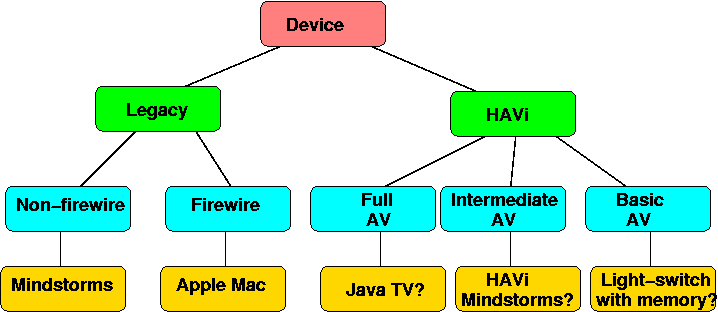
Full AV devices (FAV)
-
These can run all elements of the HAVi architecture
-
This includes a Java runtime engine, and the ability to run
Java code uploaded from other devices
-
They can act as controllers for other HAVi devices
-
They can e.g. upload a Java UI from a device and use
that to allow a user to control the device
-
e.g set-top boxes, TVs, PCs
Intermediate AV devices (IAV)
-
Cannot run Java bytecodes, so cannot act as a general purpose
controller
-
May be able to run particular native code programs, so may
be able to act as special-purpose controllers for some devices
Base AV device (BAV)
-
These can store Java bytecode and upload it to a FAV
-
They can be controlled by code running on the FAV
-
The protocol between this code and the device is not
specified, and could be anything (sockets, serial ports, etc)
HAVi control

Components of HAVi devices
-
HAVi devices may be made up of parts
-
These parts are not made explicit e.g. this is not
how the parts are specified
class TV {
Tuner tuner;
Display display;
}
-
Instead, the DCM code unit (a boot loader) installs each
component, something like
class TV_code_unit {
TV tv; // device controller
Tuner tuner; // functional unit
Display display; // functional unit
install() {
install(tv);
install(tuner);
install(display)
}
}
HAVi transport mechanisms
-
HAVi requires firewire transport mechanism
-
This is because
-
firewire is high-speed, and can carry AV data
-
firewire is hot-swappable, and devices reset the firewire bus
when they join or leave, so that join/leave events
can be generated
-
firewire will support a large number of devices per bus
-
HAVi builds a messaging layer above this, so all HAVi clients
and services communicate by message passing
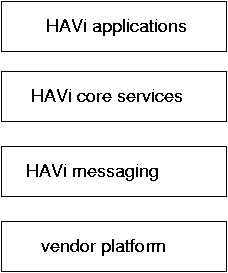
Device and Function control modules
-
HAVi devices are represented by device control module
(DCM) objects
-
Each device may have several functional elements
-
Each functional element is represented by a
functional control element (FCM) object
HAVi device and component indentifiers
-
Firewire identifies all devices on the bus
-
After a firewire bus reset, all identifiers may change
-
HAVi uses a
GUID (globally unique identifier) to identify
devices independent of these bus resets
-
Components within a device also have a
swHandle
-
A software element identifier SEID is made up of the
GUID
and the swHandle
-
The SEID is used to register, find and manipulate devices
HAVi registry
HAVi object booting
-
When a HAVi device starts up, it locates an FAV or IAV
-
It uploads a DCM (device controller module) code unit
which acts to boot the device into the HAVi network network
-
The FAV/IAV runs the DCM code unit, which installs
-
the Device Control Module (DCM) for the device
-
Functional Component Modules (FCM) for each component of the device
HAVi service advertisement
-
Devices are not registered - their s/w representatives are
-
Each DCM and FCM is registered with the Registry
-
This is done as part of the boot sequence
-
It is also done after firewire bus resets
HAVi service discovery
HAVi clients
-
A HAVi client runs as an application on a Full AV device
e.g. an ordinary computer
-
It can search for FCM's and DCM's and will get SEID'd for them
-
From an SEID it can create client-side
-
DCMClient
-
FCMClient
-
Specific objects such as
VCRClient,
ClockClient or TunerClient
-
Register event listeners
-
Set up stream connections between FCMs
-
Control devices
DCMCLient methods
Methods applicable to an entire device
-
getDeviceClass() one of FAV, IAV, BAV
-
getDeviceManufacturer()
-
getFcmCount() number of FCM modules
-
getFCMSeidList() list of FCM SEIDs
-
nativeCommand() send a native (non-HAVi) command
to the device
FCMClient methods
Methods applicable to functional modules in a device
-
getFCMType()
-
getPowerState()
-
canWink() can it "flash" or "blink"?
-
wink()
-
getWorstCaseStartupTime()
VCRClient methods
-
play()
-
stop()
-
record()
-
fastForward()
-
eject()
-
getFormat() current media format
-
getCapability() formats supported by device
TunerClient methods
-
selectService() tune to a service
-
getServiceList() possible services
-
getService() info about currently
tuned service
HAVi service invocation
-
For DCM (devices) or FCM (functions) on the same FAV (full),
objects can communicate using
-
direct procedure calls
-
callback functions
-
HAVi objects on different FAVs must communicate using HAVi messaging
-
Typically, a client uses a client-side object for the remote object, and
makes method calls on the client-side object.
The client-side object uses messages to the remote object
HAVi messaging
HAVi streams
-
Multimedia data such as video or audio streams are transferred on
a
Connection object
-
A connection is made between two FCMs
-
At each end of a connection is an
FCMPlug
-
First the plug at each end is created using the FCMs SEID, then
the connection si constructed from the plugs
HAVi user interface
-
HAVi objects can upload a user-interface as Java code to a FAV
-
The HAVi user interface assumes a TV-like display device
-
A subset of
java.awt is used, with additional
classes such as a "remote control" input object
-
All of the AWT high-level presentation classes such as
List, TextArea etc are gone
-
Events, layout managers, basic drawing objects such as
Point, Rectangle remain
(This is pretty much the subset needed to implement Swing)
-
HAVi remote control
-
The remote control device can be used as a source of events
-
The keyboard generates
KEY_PRESSED,
KEY_RELEASED events
-
The remote can generate events such as
-
VK_CHANNEL_UP
-
VK_VOLUME_DOWN
-
VK_POWER
Naive PVR
-
The following code illustrates a very simple version
of a personal video recorder
-
It is based on the code from "HAVi Programming by Example"
by Rodger Lea et al
-
The full code is available from
www.vividlogic.com/hbx
-
For simplicity it finds (any) digital VCR, and (any)
AVDisk recorder, sets up a connection between them
and starts the VCR playing
-
The code style is very much like CORBA
PVR communications
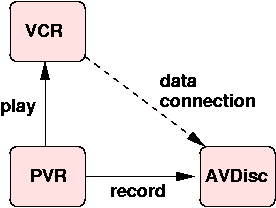
PVR class diagram
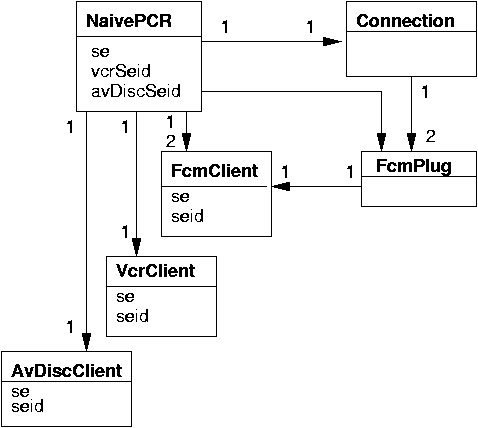
Naive PVR code
Jan Newmarch <jan@newmarch.name>
Last modified: Tue Apr 15 06:32:53 EST 2003





